Diversity and Inclusion: The Essential Guide
With the right Diversity and Inclusion strategy, your organization can develop a workplace culture in which every employee is valued. An evidence-based plan will help your diverse teams to thrive.
This guide offers some key thinking points about how we can improve practices for an inclusive work environment.
This Diversity and Inclusion guide covers the following areas:
- What is diversity?
- What are the different types of diversity?
- What is inclusion?
- Difference between diversity and inclusion
- The purpose of diversity and inclusion
- A brief history of diversity and inclusion
- How to create an inclusive workplace
- How Learning and Development Supports D&I
- The Life-Cycle: How to Foster Inclusivity from Recruitment to Exit
What is diversity?
Diversity is any aspect that differentiates groups and individuals from each other. What makes someone different might be their ethnicity, gender, disability, sexual orientation, nationality, religion or educational level.
Diversity is how we interact with these differences. The author and poet Audre Lorde wrote that we shouldn’t shy away from our differences, as she wrote, “It is not those differences between us that are separating us. It is rather our refusal to recognize those differences”.
It is not those differences between us that are separating us. It is rather our refusal to recognize those differences - Audre Lorde
A common misconception is that diversity is pretending differences do not exist. Instead, it accommodates diverse perspectives, backgrounds and points of view.
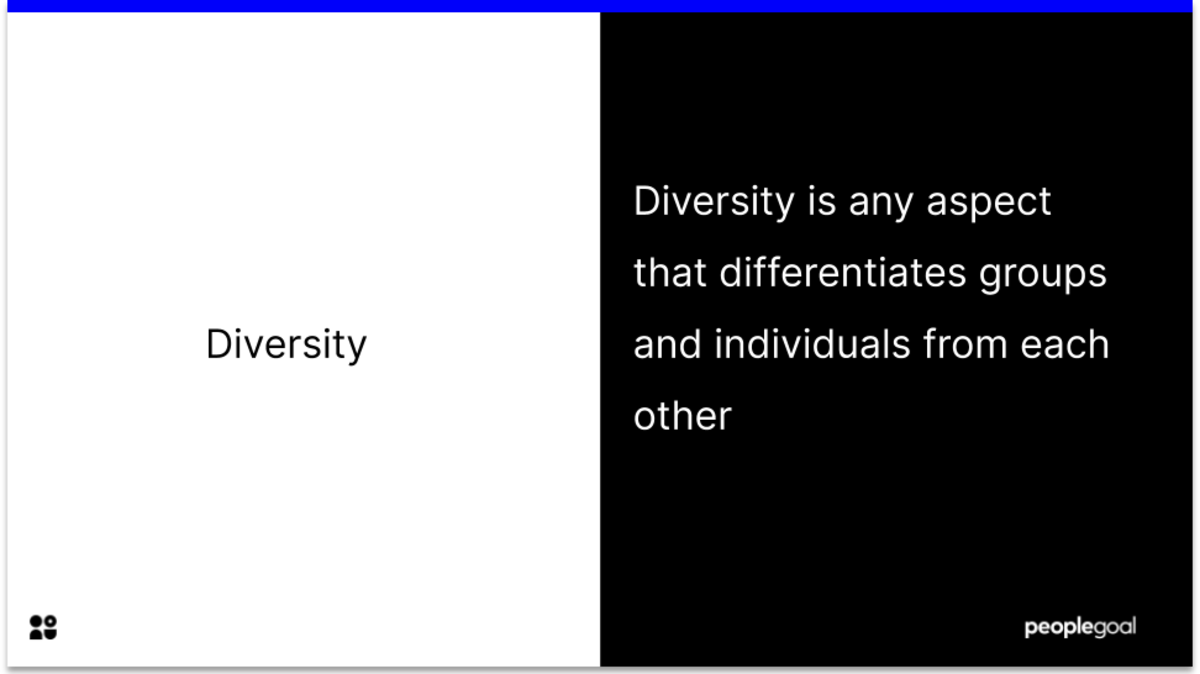
Complex diversity
Diversity is complex. Consider law professor Kimberlé Crenshaw’s concept of intersectionality - in summary, that we are not just defined by one attribute, but are made up of a network of different attributes and areas of belonging. An individual’s experience of inequalities is also complicated in this way – whether through variations of class, race, gender, etc.
It’s important that our approach to D&I bears this in mind. A culture of inclusivity will permit employees to show up for all their different attributes.
What are the different types of diversity?
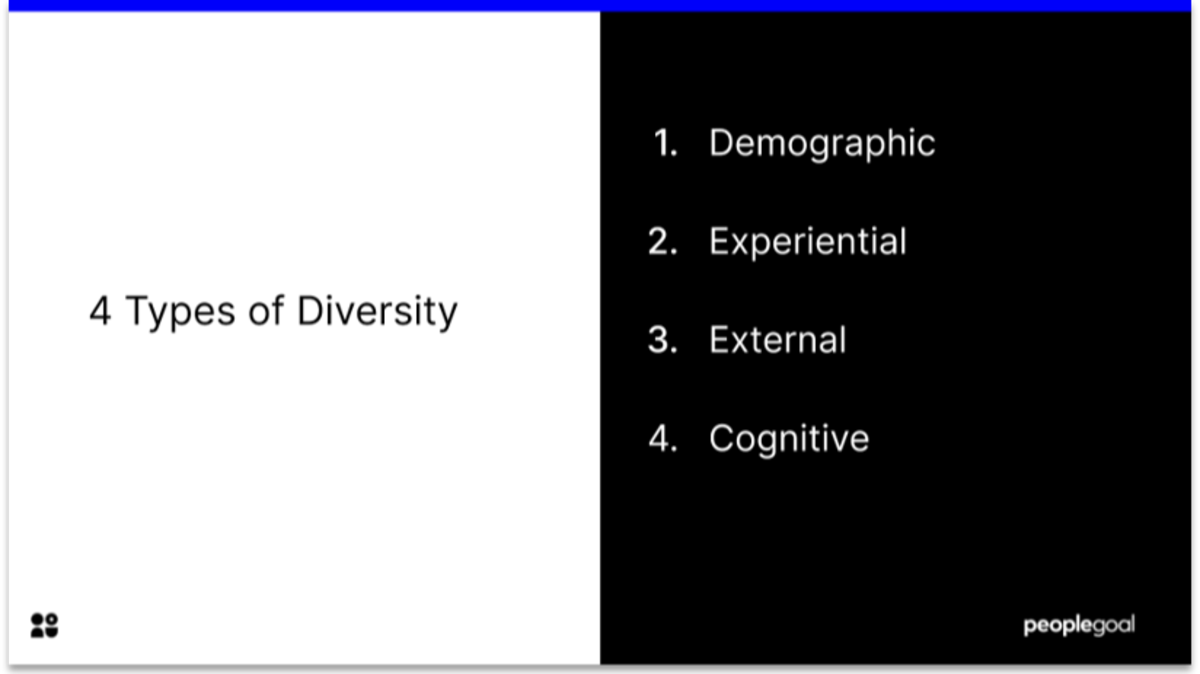
As Kimberlé Crenshaw informs us, we are complex, and made up of myriad experiences and attachments. Below I explore four different types of diversity. Be mindful however – these ‘types’ are overlapping. An employee’s experience is moulded and informed by all four of these categories.
In a Harvard Business Review article, Celia de Anca and Salvador Aragón divide these as:
1. Demographic diversity
2. Experiential diversity
3. Cognitive diversity
To their summary I have added ‘External diversity’ – the ways in which outside forces influence the way an individual works and interacts with others.
1. Demographic diversity
- Race
- Ethnicity
- Gender or sex identity
- Sexual orientation
- Age
- Physical or mental ability
- Religion
- National Identity or Immigration Status
- Socio-economic background
Under the Equality Act in the UK, some of the above are ‘protected characteristics’ – traits that it is illegal to discriminate based upon.
2. Experiential Diversity
This is how our experiences have shaped us.
- educational background
- life events and traumas
- our abilities or talents
- our ‘affinities’ – likes/dislikes
Our experiences and world-view effect our decision-making and creative output. It is important for an organization to ensure it gives voice to a range of perspectives. Affinity bias is the unconscious tendency to get along better with people who are like us.
Affinity bias can lead teams to view behaviors as acceptable merely because those who would be offended or hurt are ‘not in the room’.
But the experiences of others are often invisible to us. This outlook can put employees in exclusionary and upsetting situations.
Establishing expected behaviors is key. HR should make these explicit from the outset.
3. External Diversity
This is how external forces influence our experiences:
- marital / parental status
- political events
- geography
- caring responsibilities
- access to healthcare (mental and physical) and other essential resources
Employers and HR leaders should be conscious of how outside forces influence an individual’s ability to do their job. Particularly during the pandemic, creating an inclusive culture meant taking into account the caring responsibilities of their employees. According to a study by Kate Power, the Covid-19 pandemic has increased the unpaid care burden of women and families. A culture that recognizes and responds to this will be more inclusive.
HR should also be conscious of employee needs are not met outside of the office- such as healthcare plans or mental health support. Benefit programs should help with this.
4. Cognitive Diversity
The ways in which we approach problems will vary according to our personalities and learning styles.
Harvard Business Review recommends creating a ‘community of aspiration’ in which voices are valued for rather than despite differences of opinion. This helps individuals to collaborate as each employee feels they can make a positive contribution.
For example, introverts and extroverts will learn and communicate differently.
Reflecting on the types of diversity
De Anca and Aragón remind us that ‘types’ of diversity overlap and (much like the concept of intersectionality outlined above) will not always be clear-cut. As they write ‘categories only serve the purpose of classification; in the real world, differences between these categories are blurred. Diversity is dynamic’.
Our experiences will be greatly influenced by the environment we grew up in – and so our cultural background may well overlap with this. The types help us to see that no-one is defined by a single trait – we all have a combination of experiences and facets that make us, us.
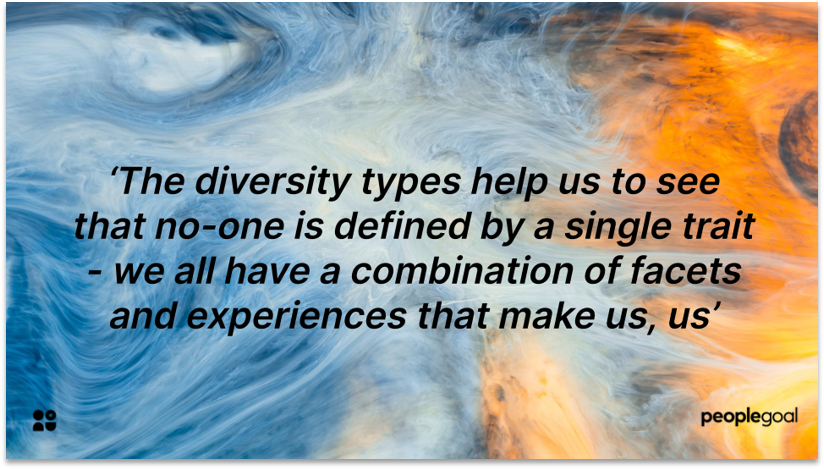
What is inclusion?
If diversity is our foundational value, inclusion is how we put these values into practice. Inclusion is the actions a company takes to create an inclusive workplace. It is the policies you put in place to encourage a diverse workforce to collaborate.
As Verna Myers said in her TedxTalk, ‘Diversity is being invited to the party. Inclusion is being asked to dance’.
HR leaders cannot assume knowledge about their teams. According to Global Diversity Practice, differences can be self-evident (such as our age, race or gender) or ‘more inherent’, for example the region we grew up in, our educational background, our tenure or income level, our religious beliefs or our parental or marital status.
Diversity is being invited to the party. Inclusion is being asked to dance - Verna Myers
Inclusion takes understanding your workforce and creating a safe environment for communication. If we are to be ‘asked to dance’, we need to think about what that means for each individual. Essentially, this is an environment in which you can be yourself, and in which differences are welcomed.
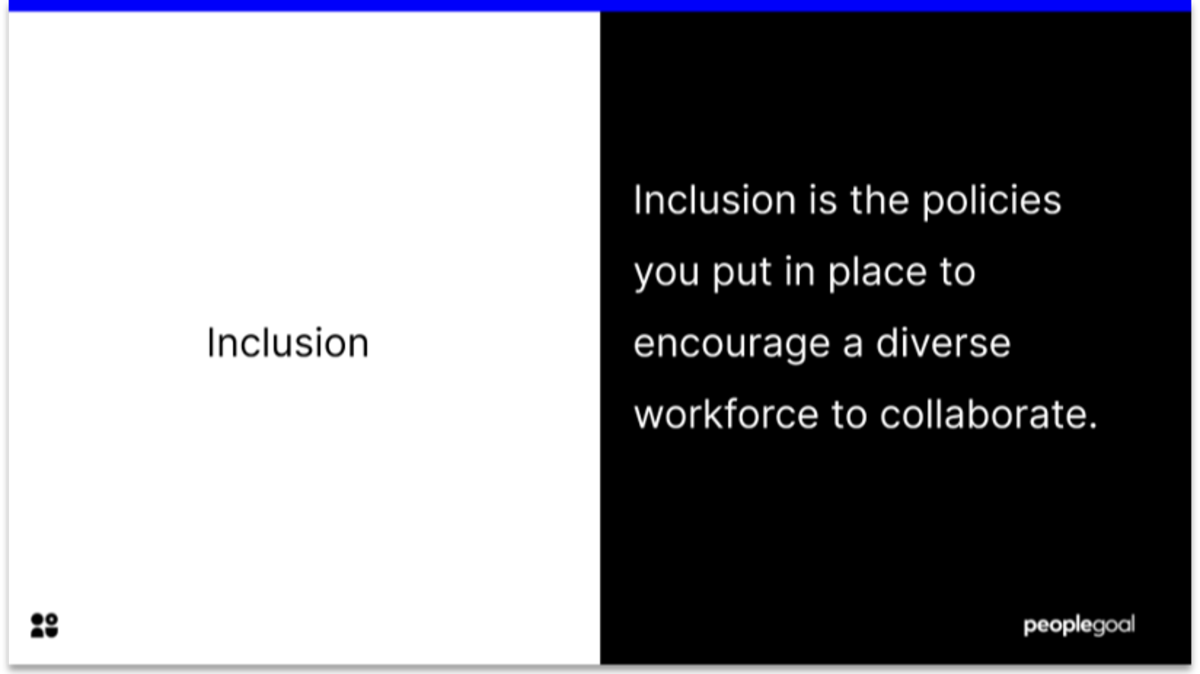
Why is it important to understand the difference between diversity and inclusion?
Fatima Dainkeh points out that “often times organizations are checking the box and saying we have a diverse racial/ethnic group, but they do not understand why their diverse staff is unhappy or unable to complete their tasks”. Diversity programmes and inclusive recruitment practices are crucial. However, it’s important to remember that D&I is not a check-box.
Something so complex and essential to how we relate to one another needs a holistic strategy. Once you workforce is more representative of the wider population, how do you then support your new hires? How do you ensure you create an environment in which they can thrive? This guide outlines some potential techniques.
What is the purpose of diversity and inclusion?
Diversity and Inclusion has myriad benefits for employees, managers, organizations and wider society. For individuals, an inclusive culture benefits mental health, career development and relationships. According to research by Yuqiang Feng and Tienan Wang, employees who feel they can be themselves while at work are more likely to display higher engagement. They name this a psychological safety climate.
An inclusive environment creates the condition for our personal and professional development. It helps us collaborate with our teams better. Diverse teams welcome a range of worldviews, perspectives and decision-making strategies. This improves innovation and creative-thinking.
In turn, companies with excellent diversity and inclusion strategy achieve better outcomes. According to Gallup, companies with over 20% of women on executive boards see substantial increases in innovation revenue.
Bottom-line aside, we have a moral duty to uphold equitable practices. The millennial workforce is more diverse than ever, with over 44% part of a minority racial or ethnic group. To best serve this generation and the next, company culture should prioritize equity.
D&I is not a passing trend, but part of many years of work. Below we will explore a brief history of diversity and inclusion in the workplace.
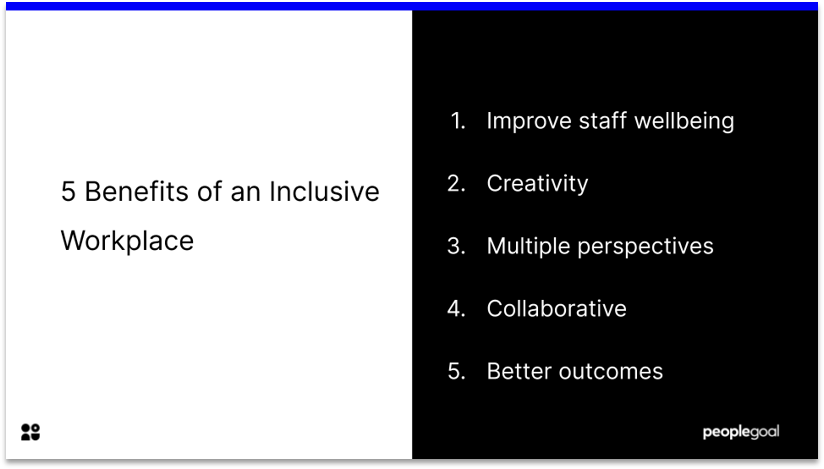
Diversity and Inclusion in the workplace: A brief history
1919: International Congress of Working Women founded
The Congress united women from the United States, France and Belgium. Women workers were crucial to food, munitions and manufacturing throughout WW1. The congress attended international conferences to advance better pay and working conditions.
1948: The army is legally desegrated
President Truman signed Executive Order 9981 to desegregate the army. 125,000 African American men fought in segregated divisions in World War Two. Some historians view this as the first piece of legislation against work discrimination.
1963: The Equal Pay Act
Congress led by John F Kennedy passed the Equal Pay Act which hoped to reduce pay differentials based on sex. Esther Peterson was a proponent of the law.
The law hoped to target the gender pay gap, as in 1960 women earned 2/3rds of their male counterparts. They were also subject to gendered state laws- some of which forbade night shifts or restricted their work hours.
The Act made it illegal to pay men and women differently for the same job.
1964: The Civil Rights Act
The Civil Rights Act of 1964 remains a crucial anti-discrimination law. It put a legal end to the segregationist “Jim Crow Laws” which had been in place since 1896.
The Civil Rights Act forbade discrimination on the basis of race, nationality or religion. The struggles of African American citizens and other minority groups did not end with this law. In 2015, Black women earned only 65 cents to every dollar a white man earned.
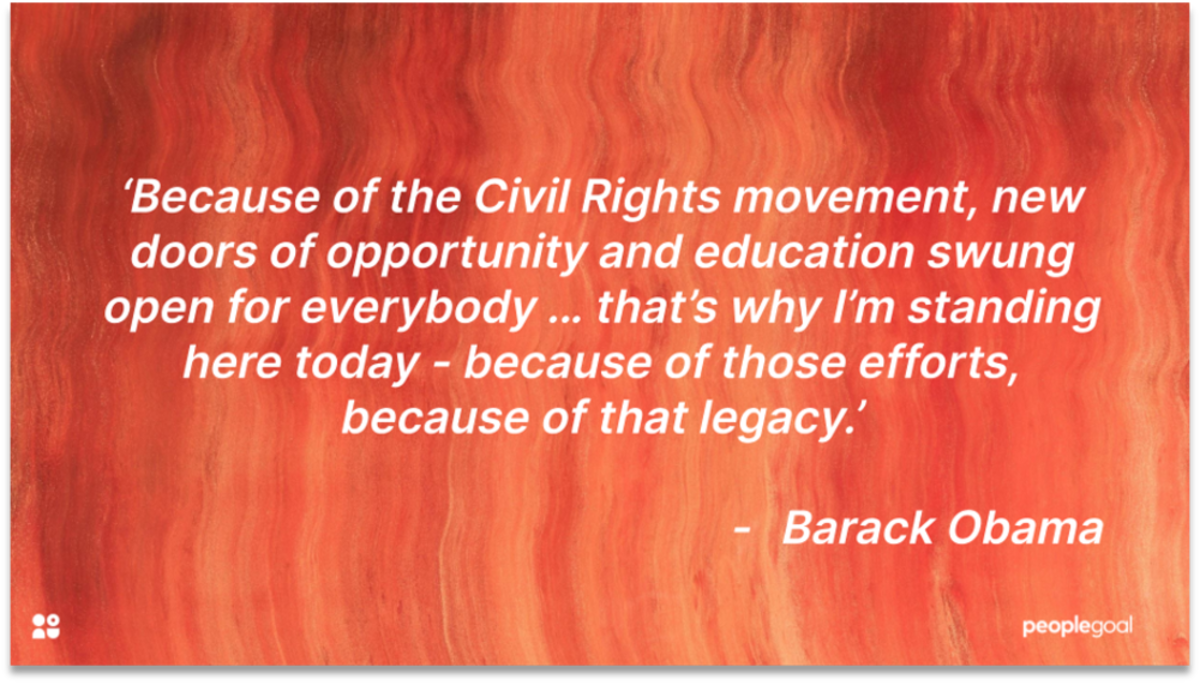
1965: Title VII of the Civil Rights Act
Many women’s rights groups at the time argued for sex discrimination to be included under the Civil Rights Act. In 1965, Title VII of the Civil Rights Act was passed, which barred employment discrimination based on sex. This inspired the founding of the National Organization for Women (NOW) in 1966.
1990: The Americans with Disabilities Act
The Americans with Disablities Act was passed in 1990, protecting people from discrimination on the grounds of a disability. In the 1980s, activists Justin Dart Jnr. and Patrisha Wright had campaigned for the codification of these rights.
1996: Ruth Bader Ginsberg challenges gender discrimination in the army
Supreme Court Justice Ruth Bader Ginsburg wrote the court’s landmark decision in United States v. Virginia ruled that it was illegal for the Virginia Military Institute to prevent women from applying.
2017: CEO Action is founded
Over 150 CEOs founded the CEO Action for Diversity and Inclusion.
June 2020: LGBTQ+ Employment Rights Codified
In June of this year, the Supreme Court ruled in three landmark cases that the Civil Rights Act also prohibits discrimination based on sexual orientation and gender identity.
The law codifies the rights of LGBTQ+ individuals; as Justice Neil M. Gorsuch wrote, “A “An employer who fires an individual merely for being gay or transgender defies the law”.
How to create an inclusive workplace
In light of the Black Lives Matter protests, attention has been drawn to how we can ‘start a conversation’ about race. The response we seek, for all D&I matters is a conversation - dialogic. Within a company, this conversation is complex – a more useful way of thinking about this is how we can create an inclusive work environment.
A conversation is, obviously, a two-way system. However, leaders should be mindful that they are not expecting underrepresented groups to educate them on how to address D&I issues. Wherever possible, D&I efforts need to tie in with learning and development. How can we educate and inform line managers and employees about historic inequalities? How can we use this learning to encourage more positive behaviors- the very behaviors we seek for an inclusive workplace?
A conversation is, obviously, about communication. Communication, particularly about complex or personal and emotive issues, only works in the right environment. Leaders should create a strategy to make their workplace a safe space in which to raise concerns. Managers should emphasize that they are open to challenge. They should use D&I training to talk openly about their vision for an inclusive workplace. Every employee should view diversity and inclusion as their responsibility – and be held accountable when they fall short.
The central focus should be that this is a shared commitment. Diversity and Inclusion does not begin and end with the office walls of HR, or an Employee Resource Group. Instead, everyone has their role to play in creating an inclusive workplace.
Below are some methods used to encourage greater inclusivity at work. Some are public and some more personal, one-on-one forms of communication. Your strategy will tailor these to the unique needs of your company.

Town Halls/ ‘All-Hands Meetings’
Start from a position of open communication. Town halls are an effective way for leadership to begin a dialogue with their employees. Senior leaders speak directly to staff to make announcements or clarify a course of action. A town hall specifically on the issue of DE&I can help start a conversation about inclusion concerns. It creates a culture of transparency that reassures staff.
Express a desire to hear about employees’ experiences, and especially, an openness to feedback. Create an invite that outlines the issues to be addressed well in advance, and offer the opportunity for suggestions of other topics to discuss.
Town halls are important for giving employees a voice. However, leaders should also do the research themselves. Managers sometimes place a burden onto underrepresented voices by expecting them to inform and educate them.
An informal speech can help managers or CEOs to communicate a willingness to change things. Outline the data you have about representation. Remind your teams of your company’s mission and values – and how diversity and inclusion align with these goals. But remember, town halls aren’t a PR spotlight. Be honest about the shortfalls in your company’s D&I efforts.
One-on-Ones
Some individuals will not be comfortable addressing their experiences in town-halls. There should be no burden on them to do this. Instead, consider one-on-one forms of communication. Managers should set time aside for personal meetings with team members. These should not be intimidating. Start from a place of humor- particularly during the pandemic – employees will feel reassured to hear something light-hearted.
Wherever managers feel comfortable, try to make yourself vulnerable - point to challenges you have faced at work. When managers talk about experiences with stress or a difficulty maintaining work-life balance, they make it known that they care about these issues.
Ask the right questions. Avoid questions that pressure the employee to discuss personal matters. If they volunteer thoughts or feelings – listen actively. Managers can try paraphrasing employees to indicate you are fully listening. For example, if one of your team says they feel their work is not adequately recognized, a manager might say, ‘Not having your work fully recognized is frustrating, and that’s not what I want as a manager. I know I can do better on that. Are they any ways in particular you’d like me to improve on this?’
This form of communication works in myriad ways. First, you acknowledge the perspective of your employees. Next, you validate that perspective by holding yourself accountable for shortfalls. Finally, you open up the floor to suggestions so that you can improve.
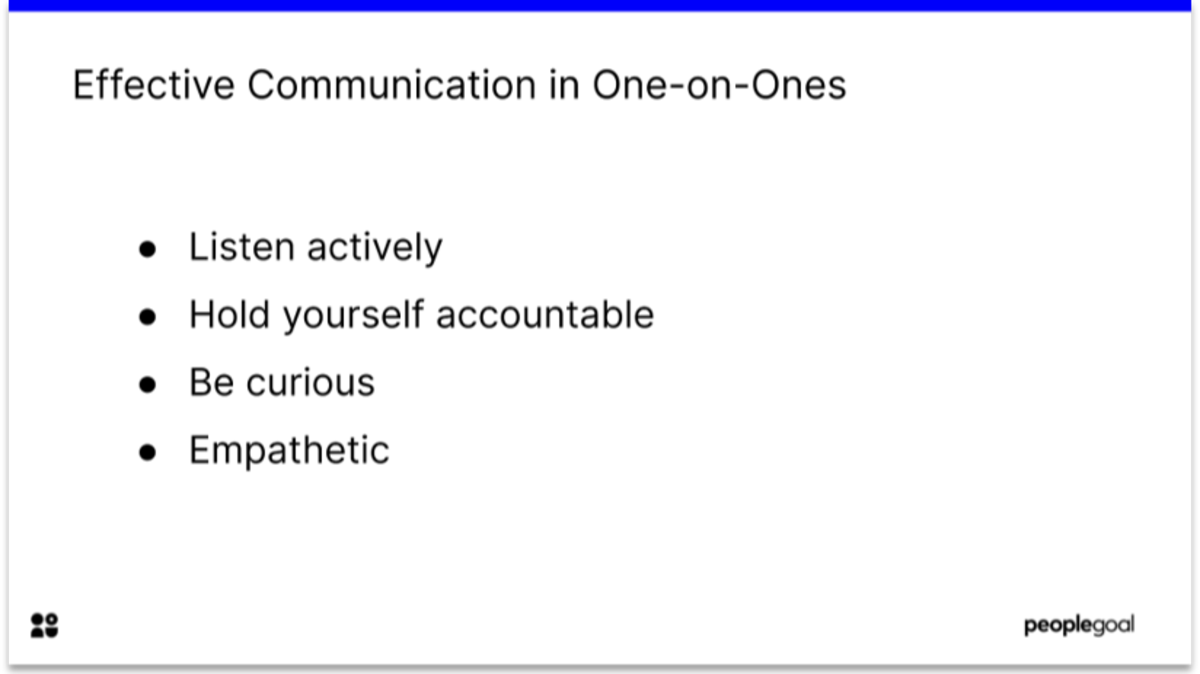
Support in different shapes and sizes
Do not assume employees will be comfortable discussing personal experiences. Historically, minority groups, women and LGBT people have had their opportunities compromised for speaking up. For example, the ‘Don’t ask don’t tell’ existed in the US army until September 2011. LGBTQ individuals were not allowed even to speak about their gender identity or sexual orientation if they wanted to serve. Town-halls and one-on-ones are therefore not one-size-fits-all solutions.
Feedback helps us grow
Even with a well-implemented Diversity & Inclusion programme, line managers, colleagues and leaders will make mistakes. There will still be moments in which employees feel excluded, or in which communication fails. Microaggressions may continue to make employees feel other to their peers. A work environment that is seriously committed to tackling these problems views mistakes as an opportunity to learn.
Manager feedback
Managers should give employees regular opportunities for feedback. This can be simply asking the question ‘What can I do better?’. How you respond to mistakes is crucial. A willingness to receive criticism is crucial. A defensive reply will worsen the problem and invalidate the voices of those who speak up. Managers should not only take criticism on board, but commit there and then to change.
Diversity and inclusion surveys
Diversity & Inclusion surveys can help gauge areas for improvement. Their anonymity means you are likely to get an honest picture of your D&I efforts. Cover a range of themes – diversity, inclusion, belonging and common purpose.
Make sure you invite employees to reflect on how the company’s culture aligns with its public persona. Use Likert scales, but also provide the opportunity for more nuanced written answers.
Timing: Ensure you make employees aware of the survey well in advance. The survey itself should not take more than 30 minutes to complete. However, HR might consider organizing employee focus groups or informal discussions around the time of the survey. This gives employees time to reflect on their experiences. The survey shouldn’t be see as an end in itself, but part of a wider cultural conversation within your organization.
What to do with the results of a diversity, equity and inclusion survey
After the survey, make use of the data to create an evidence-based strategy for D&I moving forwards.
Highlight evident problem areas and present your findings to managers. Any details about how leadership could become more inclusive needs to be communicated.
Be open with employees about the results, whether they cast your company in a glowing light or not. Publicize the results on intranets and organize a Zoom call or town-hall to discuss them with colleagues. Make clear your plan moving forwards – and then recognize wherever there is progress within your teams.
In Training- How learning and development supports D&I
HR teams can implement effective Learning and Development plans to aid their D&I processes. All levels of a company’s hierarchy should be equipped with the learning they need to cultivate an inclusive environment.
Aims of training for Diversity and Inclusion
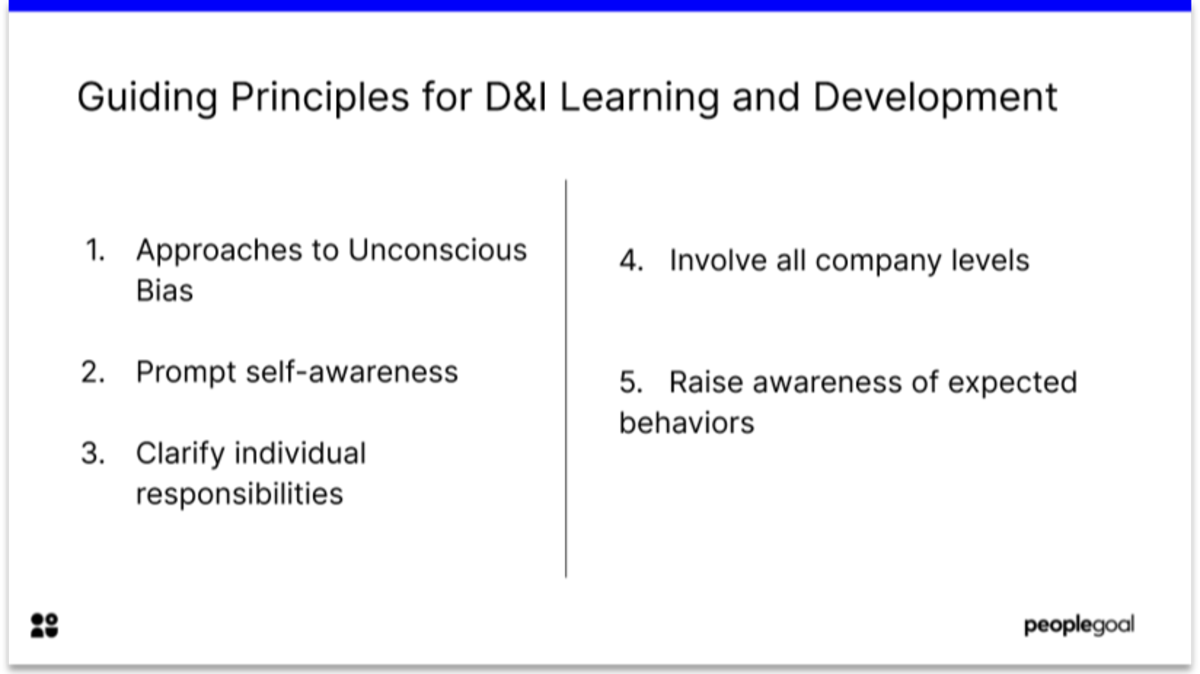
Be sure to lay out some guiding principles for any D&I training or learning.
Priorities should include :
- Approaches to unconscious bias
- Prompt self-awareness and reflection
- Clarify individual responsibilities
- Involve all company levels & departments
- Raise awareness of expected behaviors
Learning for small and medium sized companies
Diversity and inclusion learning does not have to be costly. There are a wealth of resources freely available. FutureLearn offers a free trial for their Understanding Diversity and Inclusion course. Grovo offers free unconscious bias training with engaging videos and quizzes.
Prioritize quality over quantity. Individuals learn in different ways- a women writers’ book group might engage interests and open up discussion in a more informal way. Celebrate Disability Employment Awareness Month (October) by inviting employees to offer a presentation on a person with a disability who inspires them. This creates a trusting space in which to share ideas about diversity and inclusion.
Find inspiration online. According to Harvard Business Review, the technique of ‘perspective taking’ can help. ‘Perspective taking’ is imagining you are in the place of someone from a marginalized group. Participants in the HBR study were asked to write a few sentences from that perspective. This is a simple activity, but it creates a moment of reflection that can be powerful.
Small companies have a unique opportunity to create a shared vision. It’s easier to raise awareness of your diversity and inclusion practices. Think about how groups of people in your company work together- whether that’s interns, marketing or sales. Encouraging these small groups to learn together means they’re more likely to hold each other accountable later on.
Manager training
Evidence on formal training is mixed. However, HBR research showed that manager goal-setting was effective for D&I efforts. Individuals in their study set the personal goal that they would call a colleague out the next time they heard an offensive comment. This yielded longer-term benefits to inclusive behaviors.
Sometimes Diversity and Inclusion can seem abstract, and as these issues are emotive, we can feel powerless. Training can help managers be more intentional about strategy.
Manager interview training can also transform the recruitment process. Affinity bias can hurt recruitment drives. This is when we identify with those who are similar to us, and can cause managers to unfairly favor those who look like them or speak like them.
With the right training, managers can address unconscious biases and ensure they assess candidates according to the job specification.
Employee learning
Employees appreciate opportunities for development. According to ClearCompany, 68% of employees view learning and development as the company’s most important policy. New experiences and learning new things boosts employee engagement. It’s important to think about why people seek out knowledge. This might be:
- To expand their horizons
- To uncover strengths (and weaknesses)
- To connect with others, through learning communities
- To develop skillsets for future plans
- Human curiosity
With this in mind, think about how diversity and inclusion efforts can align with learning efforts. Of course, while L&D is about personal development and self-actualization – diversity and inclusion is a collective endeavour. However, essential to D&I is the knowledge on the part of every individual in a company that they have a part to play in fostering an inclusive work environment.
Learning and development reminds us that we are all motivated by different things, and we all learn in different ways. It shows us the efficacy of employees setting personal development goals. This continues to be significant to diversity, equity and inclusion, as employees recognize their individual responsibility to uphold respectful, empathetic and equitable behaviors.
D&I learning stands out for its collaborative nature. Diversity and Inclusion learning works best when employees hold one another accountable. DE&I should represent a shared learning experience that strengthens trust within teams. Opportunities for discussion are key here- a seminar-style session works well.
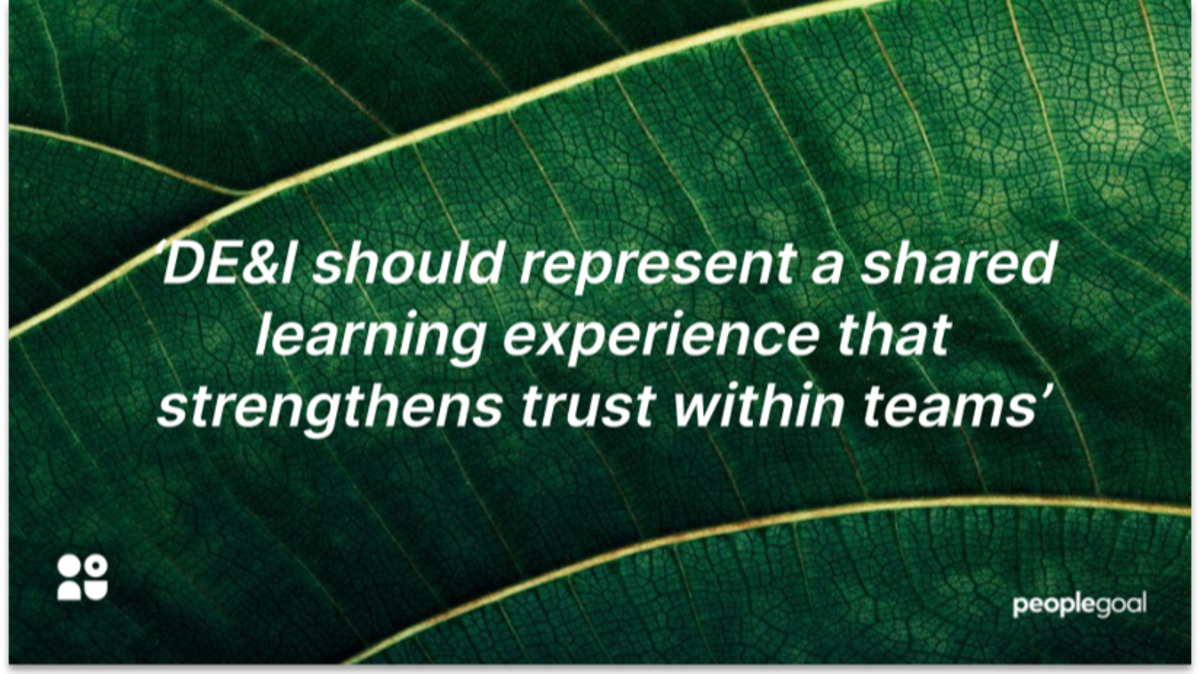
Different learning styles
Different individuals work in different ways. Auditory learners may benefit from an in-house podcast on diversity issues. Extroverted employees may benefit from plenty of sharing and discussion – whereas introverted employees may learn best through reflection activities. Having a selection of learning materials will improve engagement.
Learning to work together
Viewing D&I as a learning curve is key. Experts have frequently referred to it as a process of ‘unlearning’. Gloria Steinem wrote that "the first problem for all of us, men and women, is not to learn, but to unlearn". Our base assumptions and our internal biases are learnt stereotypes that need unpicking.
When we invite employees to start over and reconsider outdated and exclusionary attitudes, companies become more inclusive places to be. This learning is co-operative – as creating such an environment enables each individual to thrive.
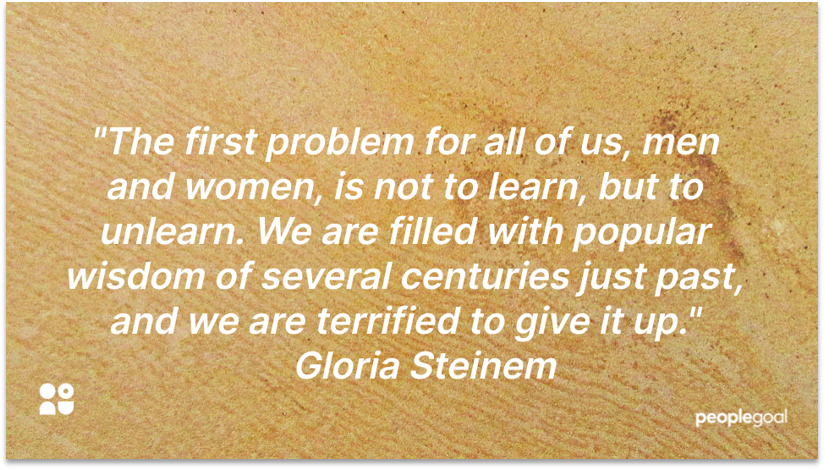
The Life-Cycle : How to foster inclusivity from recruitment to exit
As we have highlighted above, it’s important to think about diversity, equity and inclusion as guiding principles that illuminate every transaction, interaction and policy of a company.
Thinking about the ‘employee life-cycle' is key to D&I – as we need to review the barriers underrepresented groups experience at all stages of their career. Recruitment is the area most discussed regarding D&I.
Many of the landmark legal cases about diversity concern admissions to top US universities. For example, following Fisher v Texas, the Supreme Court ruled that it was constitutional to consider race in the admissions process to ensure a diverse student body.
Recruitment is a central aspect to diversity and inclusion. Companies with diverse teams reflect the communities they serve and are more likely to attract the best talent. However, recruitment should not be viewed as the be-all-and-end-all. Companies that hire a diverse workforce but do not provide an inclusive culture in which new hires flourish, have only done half the work.
This section will look at how you can promote equality and respect at all stages of an individual’s career – and at all company levels.
1) Making recruitment more inclusive
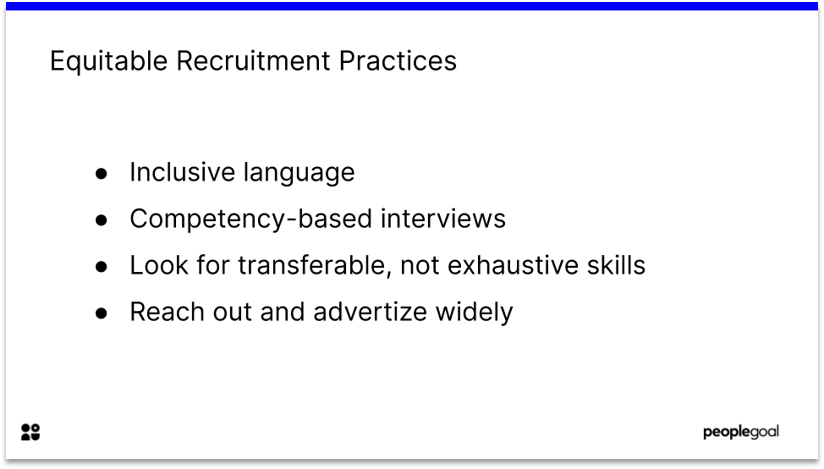
Improving your recruitment strategy is the first step to a more equitable workplace. Think about the interactions that comprise the recruitment process:
- Job Specifications and Advertisements
- The application process - online assessments, etc.
- Interviews
1) Job specifications
Job specifications are a great place to start. Anyone who has applied for a job knows these require an overhaul! References to diversity and inclusion do not go beyond legal compliance. They often list off skills in a prescriptive way – skills that could be taught on the job. Minimum requirements can be exclusionary. For example, expecting graduate-level education excludes a high proportion of the population – those who lack resources to pay tuition fees.
Pay attention to language in job specifications. For example, job specifications sometimes use gender-coded language. Studies by the Journal of Personality and Psychology found that male-dominated occupations tend to use more masculine language. Fewer women applied for these roles. This may be unconscious, but it serves to hinder equitable practices. LinkedIn.com recommends using a Gender Decoder website, that can automatically tell you if your job advert is highly gender-coded.
Overly restrictive essential functions can also sometimes turn-off applicants with disabilities. Recruitment leaders should take the time to consider what is truly essential to a role. Deborah Ruh, an inclusion strategist at a number of Fortune 500 companies, recommends taking an open-ended approach: “New employees, especially those with disabilities, may figure out different ways to get the job done...There’s value to that creativity”. Focus your job description on the results you seek, rather than a check-box list of qualifications or attributes.
2) Reaching out
Beyond language and advertizing, recruitment can reach out more actively to candidates from under-represented groups. An internship programme can approach Historically Black Colleges and Universities directly for excellent candidates. Ensure employee resource groups have a voice in the recruitment process- and that they share their values and community externally.
3) The interview process
A behavioral or competency interview style can help address access barriers. Competency questions ask employees how they would act in specific job-relevant situations. This makes it easier to evaluate different candidates – as they respond to the same scenario. The questions rely less on the on conjectures about the applicant’s personality or educational background – which can involve unconscious bias.
SHRM recommends that interviewers adopt the STAR structure:
S: Situation: Provide a specific situation, e.g., “Tell me about a time...”
T: Task: What was the task the candidate needed to complete?, e.g., “where you were challenged to learn a new skill.”
A: Action: What were the actions the candidate took to accomplish this task? e.g., “What actions did you take...?”
R: Results: What were the results of these actions? E.g. “What happened next?”
This can be a great way to create measurable and evidenced interview responses. However, interviewers also need to be open-minded about what constitutes a relevant answer. Often parents who take time off work for childcare reasons are told their responses are less relevant because of the time gap.
According to Harvard Business Review, only 4.9% of stay-at-home mothers received a call-back. Regardless of gender, parents who chose to take time off work to care for children were viewed as less reliable and ‘less committed’ than other applicants.
Interviewers need to think more creatively about this. How did this candidate demonstrate appropriate skills and behaviors at the time and within that situation. And how might training allow them to expand on these skills within your company? Companies may be missing out on hidden talent by failing to take a broader view of ‘competency’.
Interviews : the importance of bias training
Learning and development are again key to the application process. Evidence suggests that unconscious biases can be unlearned – a process called ‘debiasing’. Counter-stereotypic training challenges stereotypes about certain groups and can help cultivate a more equitable outlook. While this is by no means easy, according to psychologist Patricia Devine, with ‘intention, attention and time’ it is possible to alter perspectives.
Her words provide the key: ‘intention’ requires personal motivation. Company culture can help drive attitudes to anti-bias training. If it is a begrudging ‘add-on’ to a company’s human resources strategy, participants are unlikely to treat it with the gravity it deserves. Devine’s reference to the significance of ‘time’ should also be noted – a one-off training session will not be transformative. Instead, a company should reiterate the significance of equitable practices at all levels.
2) Onboarding: Welcoming the next generation of leaders
Onboarding is a company’s opportunity to make a great first impression. How can you ensure you create an atmosphere of openness, warmth and equity from day one?
69% of employees who stay for three years or more received great onboarding. Raise awareness of your company’s culture. Are there any community groups new hires can join? Do you offer a learning and development program?
You should also elaborate on your behavioral values – how do you expect employees to work together? How should new hires communicate with team members?
Community and Onboarding
Create opportunities for new hires to collaborate. During the first week, this should be as fun and interactive as possible – focus on team-building. Provide opportunities for new hires to get to know one another away from management. Friendship is actually key to inclusion – creating a psychologically safe environment in which new hires feel comfortable asking ‘silly’ questions and jumping into their learning.
According to Gallup, the social aspect of work is particularly important to women – women with a best friend at work are twice as likely to be engaged than those without.
Onboarding can be a great opportunity for new hires to build community at work. Make joiners aware of employee resource groups. ERGs are groups based on shared identities or experiences. A warm welcome from members of an ERG can help new employees create support networks and speak openly about any concerns.
Be sure to encourage new hires to think like a team, and support one another through the challenges of their new job.
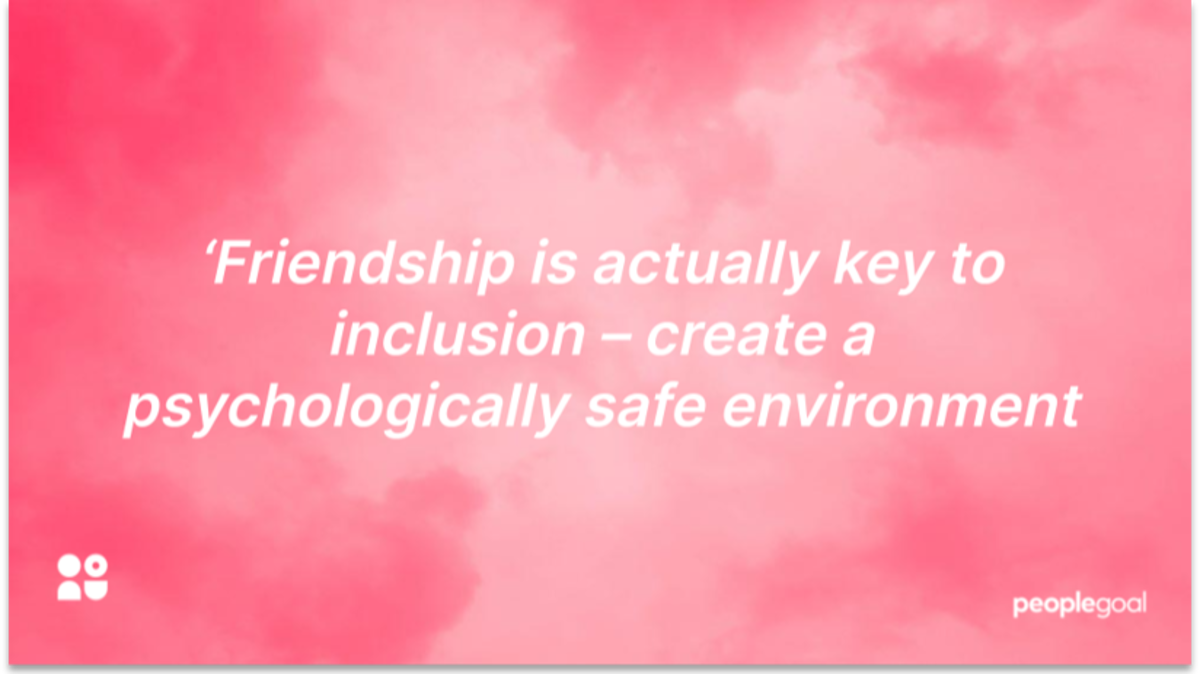
3) Equitable Career development
It’s no secret that ethnic minority staff and women tend to be under-represented on executive boards. In 2019, 37% of S&P 500 firms did not have any Black board members. The gender pay gap reveals the barriers women face to career progression. Career development should be a priority for any diversity and inclusion strategy.
Mentoring
One way to support the development of employees from under-represented groups is through mentoring.
CISION research suggests women and ethnic minority employees view mentoring as more valuable to their careers. Mentors from a shared employee research group can help provide a secure environment to consider development. External mentors can offer impartial support.
In small companies, managers or other senior figures can act as mentors by scheduling regular one-on-ones. Adopting a coaching management style can also help reap some of the benefits of a formal mentoring program. This involves building trust and open communication with employees. A coaching manager is actively invested in his employee’s goals, and sets SMART targets with them.
Mentors should help diverse employees reach actionable development plans.
Diversity and Inclusion Strategy: A Responsibility for All
HR teams create a strategy for D&I. However, every employee is responsible for upholding values of equity. The millennial workforce is motivated by a sense of purpose and opportunities to create positive change in society. They thrive through connectivity – open communication and outspokenness. Fortunately, these are attributes that cultivate truly inclusive work environments.
Play to the strengths of your diverse teams. Communicate openly and empathetically, and encourage them to do the same. Create common purpose around your values of diversity and inclusion. Inspire employees to work together, allowing our differences to boost creativity and innovation.
Content Team

